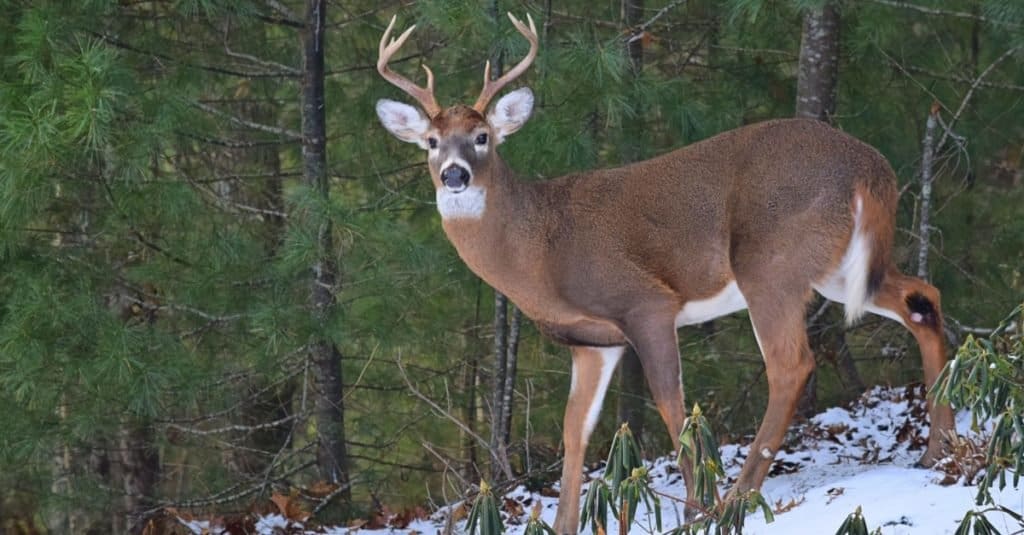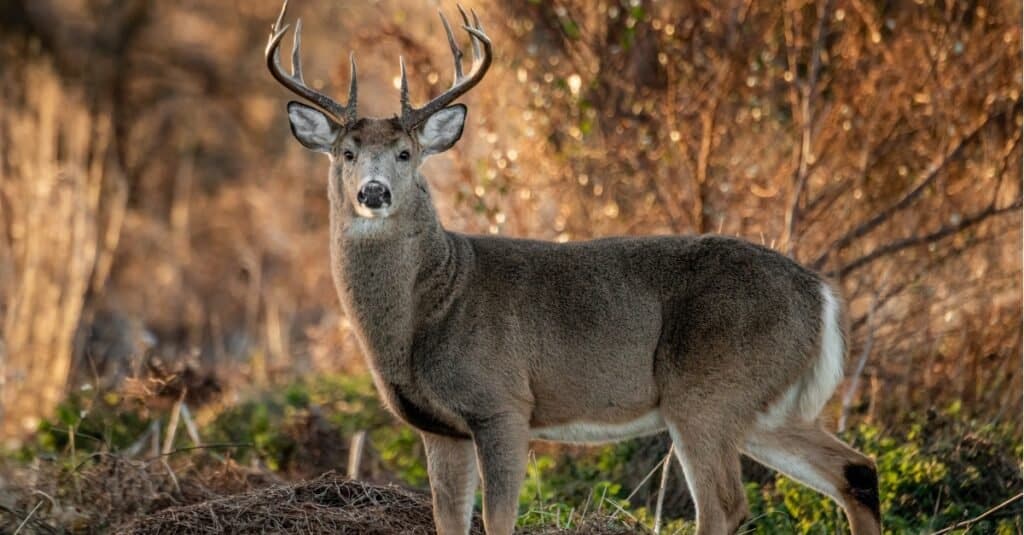The state of Idaho is home to the deepest canyon in North America. Idaho is a northwestern U.S. state with a lot of protected land. The population of Idaho is roughly 1.9 million, and many of its residents live in Boise. Idaho is stunning and full of things to see. If you are an outdoors lover, you won’t get bored visiting this marvelous state.
Whitetail deer roam throughout the woods in Idaho. They are most common north of the Salmon River, but residents are reporting seeing whitetail deer in Central Idaho. Deer hunting is very popular in the state, especially for whitetail deer. If you are curious about the largest whitetail deer ever caught in Idaho, keep reading! We will also dive into other common animals in the state and Idaho’s deer season.
About Whitetail Deer

White-tailed deer live throughout North, South, and Central America.
©Michael Sean OLeary/Shutterstock.com
Whitetail deer are easy to spot and live throughout North, South, and Central America. They are medium-sized deer with differences in size and color depending on where they live. Whitetail deer, also known as Virginia deer, can be found in Mississippi, Illinois, Texas, Ohio, Indiana, Florida, New York, Maryland, and more. There are 26 subspecies of whitetail deer. For example, the Carmen Mountains white-tailed deer live on the Texas-Mexico border in the Sierra Del Carmen mountains. Another subspecies is the South American white-tailed deer which mainly lives in the Northern half of Venezuela.
Whitetail Deer: Size and Appearance
Whitetail deer vary in size and appearance, even within the same subspecies. The size and thickness of their coats depend on where they live. For example, whitetail deer living in cold regions are smaller than whitetail deer living in warm regions. However, on average, an adult male whitetail deer weighs 150 to 300 pounds. Doe, an adult female deer, weighs between 88 to 198 pounds. However, there are exceptions to this rule. For example, adult whitetail deer from the Florida keys are very small, weighing about 77 to 110 pounds.
Although their appearance varies, there are common characteristics that make these deer stand out. Whitetail deer have white fur under their tail and a white mark around their eyes. Their coat changes color with each season. In summer and spring, whitetail deer have red and brown coats, which change and thicken to a greyish-brown. Male whitetail deer, also known as bucks, have antlers. Some antlers are branching, while others are spikes. The healthier a deer is, the more ‘branches’ their antlers have, but this also depends on its environment and age.
Whitetail Deer: Diet
Whitetail deer aren’t picky eaters, but their tastes change in winter when food is scarce. They graze on grass and look for nuts, berries, and seeds. Whitetail deer eat a lot of food, which helps them keep a healthy and thick coat during winter. Deer have strong stomachs, which help them digest foods toxic to our stomachs, like mushrooms and poison ivy. Whitetail deer are almost entirely herbivores, but scientists have observed some whitetail deer ravishing trapped and nesting birds, and field mice. More commonly, they eat woody plants, hay, and wildflowers.
Whitetail Deer: Predators
Whitetail deer have many natural predators. They use their thick coats to blend in with the forests and are fast runners. This is why we often see whitetail deer running quickly after spotting movement or hearing sound. Whitetail deer are often hunted by animals like:
- Bobcats
- Jaguars
- Wolves
- American Alligators
- Cougars
- Wolverines
- Black Bears
The Largest Whitetail Deer Ever Caught in Idaho

In Idaho, the largest whitetail deer ever caught was 186 7/8 inches.
©iStock.com/Harry Collins
The largest whitetail deer ever caught in Idaho was a whopping 186 7/8 inches. Ronald M. McLamb caught this impressive animal in 2001. Second place for the largest whitetail deer ever caught in Idaho 186 4/8 inches by Mark A Schilling in 2005. As impressive as these numbers are, hunters have caught larger whitetail deer in other parts of the U.S. and North America. For example, in 1977, a hunter in Ontario, Canada caught a massive whitetail deer which is estimated to have weighed 540 pounds!
Other Common Animals in Idaho
You can find snow-capped mountains, beautiful clear lakes, and steep canyons in Idaho, which provide homes for thousands of animals. Idaho impressively contains several stretches of the Rocky Mountains, which have diverse wildlife. Interestingly, 38% of Idaho’s land belongs to the United States Forest Service. Some of the wildlife creatures are dangerous, like grizzly bears. There are also caribou, bald eagles, wolverines, and prairie rattlesnakes. You can also fish in many of Idaho’s vast and beautiful lakes and find cutthroat trout, rainbow trout, brook trout, catfish, walleye, smallmouth bass, and largemouth bass.
One of the Rarest Animals in Idaho

Northern Idaho ground squirrels are extremely rare due to their habitat being fragmented by fire prevention methods.
©Nature’s Charm/Shutterstock.com
Northern Idaho ground squirrels are so rare that they can only be found in two Idaho counties – Adams and Valley. It is estimated that fewer than 1,000 of these squirrels are left in the wild and the future for them looks uncertain. Fire prevention methods have caused the animal’s habitat to become fragmented – leaving the surviving populations to live in an unconnected range. This inability to travel the traditional range has left isolated islands of these ground squirrels.
In coats of dark reddish gray with reddish brown spots, the Northern Idaho ground squirrel has a short, narrow tail, tan feet and ears, and a creamy white eye ring. This rare little squirrel eats large amounts of grass seed, stems, and other leafy green vegetation to store enough fat reserves for its eight-month hibernation period – lasting from late August to early May.
The photo featured at the top of this post is © iStock.com/steverts
Thank you for reading! Have some feedback for us? Contact the AZ Animals editorial team.






